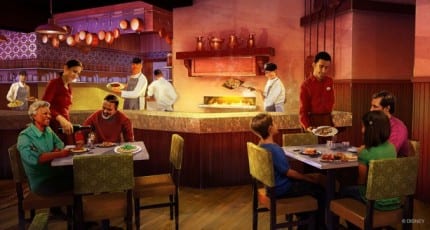From Pam Brandon, Disney Parks Food Writer and posted on the Disney Parks Blog.
Opening Dec. 18, Trattoria al Forno is the newest Disney dining experience, and together Walt Disney Imagineering and Disney Parks Food & Beverage Concept Development have crafted a backstory that builds upon the Disney legacy of storytelling and originality. Trattoria al Forno has been a creative collaboration bringing story elements such as authentic food and ingredients, a wine list featuring 100% Italian wines, and décor together to create an exciting new dining experience for Walt Disney World Resort guests.
“The Trattoria al Forno story was inspired by the authentic Italian menu and the rich storytelling of the turn-of-the-century boardwalk setting, says Missy Renard, Walt Disney Imagineering resorts art director. “Working closely with the Food & Beverage Concept Development team throughout the project was critical to the seamless merging of the story, menu and design – it was a shared vision.”

The story begins with an Italian family that ran a modest tavern and boarding house on the boardwalk, which expanded over the years into a popular restaurant. The menu’s mix of authentic and innovative dishes supports the story of the restaurant being handed down, with each generation adding their own touches to the meals and the restaurant’s design. The color palette throughout is inspired by the fresh ingredients used to make the flavorful dishes.
The new restaurant is arranged as a series of separate rooms, starting with the original Entrata, or entrance, where the story begins. An arched brick wall with an aged keystone medallion anchors the room and introduces the traditional building materials used throughout the restaurant. Along the back wall, a custom wine cabinet displays authentic regional wines offered on the menu. Vintage family photos line the walls and introduce the generational story.
“As the restaurant was growing, boardinghouse rooms were converted into additional dining spaces,” explains Renard. “There are four distinct dining rooms, with furnishings, finishes and lighting relating to the character of each original boarding house room.” The first room, the Cucina, is designed as the eat-in kitchen for the boarding house guests. The forno, or oven, with its rustic wood mantle and copper hood, is the centerpiece. Next is the Sala da Pranzo, the formal dining room, which showcases the family’s fine silver, glassware and eclectic china in a grand hutch, with two crystal chandeliers above in the vaulted ceiling. “The finishes are more opulent – carpet, draperies, settee-style seating and a communal table in front of the show kitchen,” says Renard.
The Sala da Pranzo leads into Salotto, or living room, of the old boarding house, now a dining area with tufted circular booths and upholstered chairs, and photos of vintage Italian market scenes decorating the walls. Finally, the Taverna is a secluded dining area located in the structure’s original tavern, where the mirrored back bar still hangs in front of exposed brick walls.
“The three main dining rooms are open to the show kitchen and to each other, but the styling differences in each create individual dining experiences,” says Renard. “The result is combination of intimate and lively dining spaces with a tailored progression of storytelling.”
- Disney Hotel wins Marriott Hotel of the Year Award - July 26, 2024
- All-Female Classic Universal Monsters Headline HHN House - July 25, 2024
- Howl-O-Sprint – Run for Your Life: Friday, Sept. 13 - July 24, 2024





